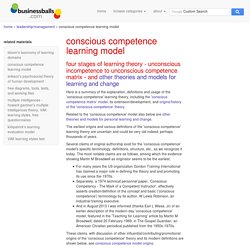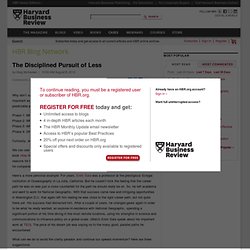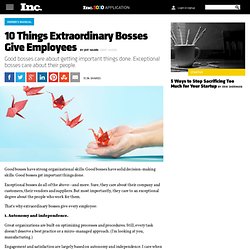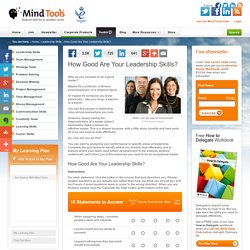

Just finding ways of helping me and others learn
Conscious competence learning model matrix- unconscious incompetence to unconscious competence. Conscious competence theory - summary outline The conscious competence theory and related matrix model explain the process and stages of learning a new skill (or behaviour, ability, technique, etc.)

The concept is most commonly known as the 'conscious competence learning model', or 'conscious competence learning theory'; sometimes 'conscious competence ladder' or 'conscious competence matrix'. Other descriptions are used, including terminology relating to 'conscious skilled' and 'conscious unskilled' (which incidentally are preferred by Gordon Training). Occasionally in more recent adapted versions a fifth stage or level is added to the conscious competance theory, although there is no single definitive five-stage model, despite there being plenty of very useful and valid debate about what the fifth stage might be. learning and training in stages.
PULSEInventoryofLeadershipStyles_0. ANGELICA. How to: Leading high-performing teams - Inspired Executives. What makes teams that are continuously and consistently high-performing unique?

Is there a secret ingredient that makes them click? How can executives support and accelerate this process? In order to be successful, every team needs a common goal that is known, understood and accepted by all members, each feeling individually responsible for its accomplishment. In their book ‘The Wisdom of Teams’, Jon Katzenbach and Douglas Smith state ‘high performance teams typically reflect strong extensions of the basic characteristics of teams’.
These ‘strong extensions’ grow out of an intense commitment to the team’s mutual purpose. For teams to be able to perform effectively there are some bottom-line requirements. Emotional Intelligence theories - Daniel Goleman's EQ concepts. This webpage is a new format for mobile/small screens.

Please send your feedback if it fails to operate well. Thanks. Daniel Goleman Introduces Emotional Intelligence. Neurolinguistics: Language and biology. Neurolinguistics: Language and biology Central Nervous System Peripheral Nervous System basic cellular unit (chemical transmission, neurotransmitters dopamine, serotonin, acetylcholine) 1.

Brain anatomy: The brain (average weight 1400gms) has structure Neurology: the science and medicine of the brain (related to neuron = brain cell). Neuroscience: just the science part of neurology, plus (sometimes) the study of artificial neural networks (i.e. connectionism). Emotional Intelligence and Leadership - with Visual Funk and gWizz. Self_directed_learning. Teaching and Learning Resources / Andragogy. Just as there is no one theory that explains how humans learn, no single theory of adult learning has emerged to unify the field.

The best known theory of adult learning is Knowles’ andragogy. As a teacher, writer, and leader in the field of adult education, Knowles was an innovator, responding to the needs of the field as he perceived them and, as such, he was a key figure in the growth and practice of adult education throughout the Western world. However, as many critics have noted, both his theory and practice embodied his own value system. Kolb's learning styles, experiential learning theory, kolb's learning styles inventory and diagram. We have some very exciting plans for Businessballs.

Later this month, we will be launching a new visual identity, refreshing the design of the site and adding lots of new functionality to enhance your learning experience. Phase 2 will include badges, learning plans linked to accredited competency frameworks, wikis (for collaborative content development) and new content from international thought leaders and academics. The site will continue to follow our ethos of free work and life learning, and the redevelopment and ongoing management will be delivered by our partner Accipio. If you are interested in contributing content or your view on where we should take businessballs next, please email ask@businessballs.com. David Kolb's learning styles model and experiential learning theory (ELT) What Makes a Good Leader. Davidstegall: The Four Leadership Traits of Highly Collaborative Leaders ht. Collaboration taps in to a broader pool of ideas.

It maximizes the talents and abilities of your people. An inclusive culture is more flexible and adaptable. The Disciplined Pursuit of Less - Greg McKeown. By Greg McKeown | 10:00 AM August 8, 2012 Why don’t successful people and organizations automatically become very successful?

One important explanation is due to what I call “the clarity paradox,” which can be summed up in four predictable phases: Phase 1: When we really have clarity of purpose, it leads to success. Phase 2: When we have success, it leads to more options and opportunities. 10 Things Extraordinary Bosses Give Employees. Good bosses have strong organizational skills.

Good bosses have solid decision-making skills. Good bosses get important things done. Exceptional bosses do all of the above--and more. Sure, they care about their company and customers, their vendors and suppliers. But most importantly, they care to an exceptional degree about the people who work for them. That's why extraordinary bosses give every employee: 1. Great organizations are built on optimizing processes and procedures. Engagement and satisfaction are largely based on autonomy and independence. Plus, freedom breeds innovation: Even heavily process-oriented positions have room for different approaches. Whenever possible, give your employees the autonomy and independence to work the way they work best. 2.
While every job should include some degree of independence, every job does also need basic expectations for how specific situations should be handled. 3. Plus, goals are fun. No one likes work. 4. 5. 6. Stephen R. Covey » Blog Archive » The Leader Formula: The 4 things that make a good leader. Each week we will be asking Dr. Covey to comment on common questions. This week we ask: what makes a great leader? Q: What makes a great leader? A: My definition of leadership is communicating to people their worth and potential so clearly that they are inspired to see it in themselves. Q: You often say that leadership is a choice not a position. A: Because of the definition I use for leadership, the ability to become such a leader is a choice that any person can make; any parent or grandparent, any teacher, any coach, any co-worker, and friend. How Good Are Your Leadership Skills? - Leadership Training from MindTools. What's your key area for improvement?

© iStockphoto/hidesy Who do you consider to be a good leader? Maybe it's a politician, a famous businessperson, or a religious figure. Ken Robinson: How schools kill creativity. Ken Robinson: Changing Education Paradigms.